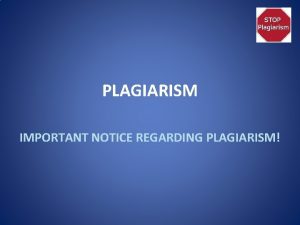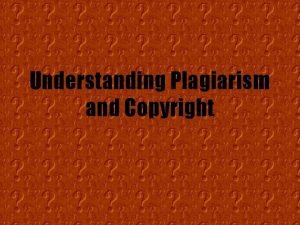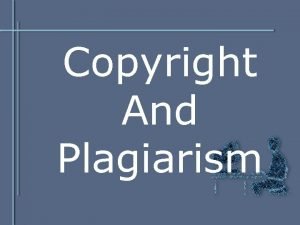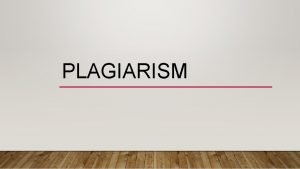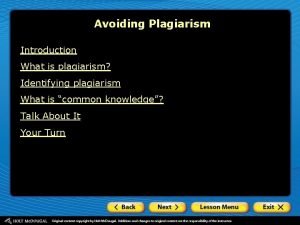PLAGIARISM COPYRIGHT WHAT IS PLAGIARISM Plagiarism is the










- Slides: 10

PLAGIARISM & COPYRIGHT

WHAT IS PLAGIARISM ? * Plagiarism is the unauthorized use or close imitation of the language and thoughts of another author and the representation of them as one's own original work.

PLAGIARISM CONT. Plagiarism is theft. Using someone's work or ideas and passing them off as your own by not giving credit to the authors is legally and ethically wrong. You could even be taken to court over it.

How Can Students Avoid Plagiarism? To avoid plagiarism, you must give credit whenever you use • another person’s idea, opinion, or theory; • any facts, statistics, graphs, drawings—any pieces of information—that are not common knowledge; • quotations of another person’s actual spoken or written words; or • paraphrase of another person’s spoken or written words.

What is Copyright? Copyright is a form of protection provided by the laws of the nation to the authors of “original works of authorship, ” including literary, dramatic, musical, artistic, and certain other intellectual works. This protection is available to both published and unpublished works.

Copyright cont. • • Copyright" © refers to a body of law that establishes an author's right to own his or her works in the same way that a homeowner owns his or her home or you own your car. Copyright protects artists, writers, and other creative people by ensuring that they, and only they, can profit from their work. Copyright is why it's illegal to copy and sell movies on DVD or download privately owned music from the Web without paying for it. Most published research--including the books and journal articles you need for your academic research--is privately held, copyrighted material. This is why there are so many ebooks, databases, and journals that you can only access through the Library's web site: the Library has to pay annual fees to the copyright holders for the right to provide access to this intellectual property for you over the Web. This is also why it's important that you give credit in your research projects to the authors whose words and ideas you use. Citing your resources by including authors' names and a bibliography whenever you present research both acknowledges the copyrights of the authors whose works you have used and protects you from allegations of plagiarism.

When does Copyright Protection begin? Copyright protection begins when any of the above described work is actually created and fixed in a tangible form.

When does Copyright Protection end, or expire? • The Berne Convention establishes a general and minimum period that lasts the life of the author and fifty years after his (or her) death. Cinematographic works and photographic works have a minimum period of protection of 50 and 25 years upon the date of creation, respectively. This applies to any country that has signed the Berne Convention, and these are just the minimum periods of protection. A member country is entitled to establish greater periods of protection, but never less than what has been established by the Berne Convention.

What Works Are Protected? Copyrightable works include the ff. categories: 1. literary works; 2. musical works, including any accompanying words 3. dramatic works, including any accompanying music 4. pantomimes and choreographic works 5. pictorial, graphic, and sculptural works 6. motion pictures and other audiovisual works 7. sound recordings 8. architectural works

What Is Not Protected by Copyright? • Works that have not been fixed in a tangible form of expression (for example, choreographic works that have not been notated or recorded, or improvisational speeches or performances that have not been written or recorded) • Titles, names, short phrases, and slogans; familiar symbols or designs; mere variations of typographic ornamentation, lettering, or coloring; mere listings of ingredients or contents • Ideas, procedures, methods, systems, processes, concepts, principles, discoveries, or devices, as distinguished from a description, explanation, or illustration • Works consisting entirely of information that is common property and containing no original authorship (for example: standard calendars, height and weight charts, tape measures and rulers, and lists or tables taken from public documents or other common sources)











